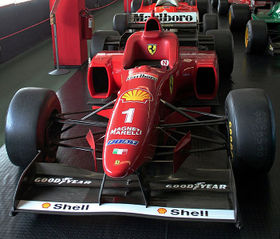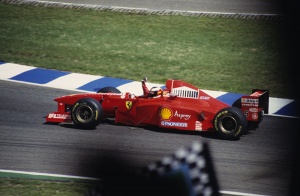Ferrari F310
|
| |
| Ferrari F310/B | |
|---|---|
| Category | Formula One |
| Constructor | Ferrari |
| Team/s | Scuderia Ferrari |
| Designer | John Barnard |
| Drivers | 1./5. Michael Schumacher 2./6. Eddie Irvine |
| Chassis | carbon-fibre and honeycomb composite structure |
| Suspension (front) | pushrod with torsion bars |
| Suspension (rear) | pushrod with torsion bars |
| Engines | Ferrari 046 (1996) and 046/2 (1997) 75-degree V10s |
| Gearbox | Ferrari six- or seven-speed transverse semi-automatic |
| Fuel | Shell |
| Tires | Goodyear Tire and Rubber Company |
| Debut | 1996 Australian Grand Prix |
| Races competed | 33 |
| Constructors' Championships | 0 |
| Drivers' Championships | 0 |
| Race victories | 8 |
| Pole positions | 7 |
| Fastest laps | 5 |
| Video | Qualifying lap at the Spa-Francorchamps circuit in the Ferrari F310-B driven by Michael Schumacher |
The Ferrari F310, and its evolution, the F310B, was the Formula One racing car with which the Ferrari team competed in the 1996 and 1997 seasons. It was driven in both years by Michael Schumacher and Eddie Irvine.
The F310 and F310B won a total of eight Grands Prix, 22 podiums, 7 pole positions and 172 points. The car would set the ground work for the next year car, the F300 which would also take the championship to the final round in 1998.
F310
The F310 proved to be a front-running car, but without the outright pace or superb reliability which led to the Williams FW18s dominating 1996. Schumacher was able to win three Grands Prix, but the F310's shortcomings were shown by Irvine's run of eight consecutive retirements, most of them mechanical, as well as three straight double retirements. Development also proved troublesome, with the cars having to use the F1 1995 car's parts early in the season whilst structural problems were cured.
This car was notable as being the first Ferrari F1 car to stray from the traditional V12 engine format into the then more conventional engine format. The name F310 refers to the engine type, a 3 litre, 10 cylinder (V10) - a similar nomenclature consistent with that used for Ferrari's F1 cars from 1966 to 1980, and more recently, 2006 (the 312, 312B, 312T, and Ferrari 248). The engine was also called the 310.
The F310 was the only car in the 1996 field to have a low nose, with the high nose now very much in vogue and aerodynamically preferred. From the word go chief designer John Barnard announced his intentions to design a high held nose for the car, saying that the F310 would be an ongoing project with the ultimate goal to win the world championship.
F310B
With the hiring of Rory Byrne and Ross Brawn to replace Barnard, part of the dream-team that would give Ferrari six straight contructors' championships from 1999 to 2004, they used the F310 as a base for the F310B. The car was slightly more streamlined but still lacked both the engine performance and the aero-package of the ultra successful Williams-Renault package of the FW19.
Regardless, double-champion Michael Schumacher held truth on his 1995 promise that "in 1996 we will win three grand prix, then in 1997 we will challenge for the championship" by taking the challenge to the last round. He was however unable to hold off a storming drive by title challenger Jacques Villeneuve and a botched attempt at blocking the line ended up with Schumacher in the gravel, retired and eventually to have his second place in the championship stricken.
Complete Formula One Results
(key) (results in bold indicate pole position)
| Year | Team | Engine | Tyres | Drivers | 1 | 2 | 3 | 4 | 5 | 6 | 7 | 8 | 9 | 10 | 11 | 12 | 13 | 14 | 15 | 16 | 17 | Points | WCC |
|---|---|---|---|---|---|---|---|---|---|---|---|---|---|---|---|---|---|---|---|---|---|---|---|
| 1996 | Ferrari | Ferrari V10 | G | AUS | BRA | ARG | EUR | SMR | MON | ESP | CAN | FRA | GBR | GER | HUN | BEL | ITA | POR | JPN | 70 | 2nd | ||
| Michael Schumacher | Ret | 3 | Ret | 2 | 2 | Ret | 1 | Ret | DNS | Ret | 4 | 9 | 1 | 1 | 3 | 2 | |||||||
| Eddie Irvine | 3 | 7 | 5 | Ret | 4 | 7 | Ret | Ret | Ret | Ret | Ret | Ret | Ret | Ret | 5 | Ret | |||||||
| 1997 | Ferrari | Ferrari V10 | G | AUS | BRA | ARG | SMR | MON | ESP | CAN | FRA | GBR | GER | HUN | BEL | ITA | AUT | LUX | JPN | EUR | 102 | 2nd | |
| Michael Schumacher | 2 | 5 | Ret | 2 | 1 | 4 | 1 | 1 | Ret | 2 | 4 | 1 | 6 | 6 | Ret | 1 | Ret | ||||||
| Eddie Irvine | Ret | 16 | 2 | 3 | 3 | 12 | Ret | 3 | Ret | Ret | 9 | 10 | 8 | Ret | Ret | 3 | 5 |
| Ferrari Formula One cars | |||||||||||||||||||||||||||||||||||||||||
| 40s | 1950s | 1960s | 1970s | ||||||||||||||||||||||||||||||||||||||
| 8 | 9 | 0 | 1 | 2 | 3 | 4 | 5 | 6 | 7 | 8 | 9 | 0 | 1 | 2 | 3 | 4 | 5 | 6 | 7 | 8 | 9 | 0 | 1 | 2 | 3 | 4 | 5 | 6 | 7 | 8 | 9 | ||||||||||
| 125 | 275 340 375 |
500 | 553 625 |
555 D50 |
801 | 412 246 |
256 | 156 | 158 1512 |
312 | 312 B | 312 T | |||||||||||||||||||||||||||||
| 1980s | 1990s | 2000s | |||||||||||||||||||||||||||||||||||||||
| 0 | 1 | 2 | 3 | 4 | 5 | 6 | 7 | 8 | 9 | 0 | 1 | 2 | 3 | 4 | 5 | 6 | 7 | 8 | 9 | 0 | 1 | 2 | 3 | 4 | 5 | 6 | 7 | 8 | 9 | ||||||||||||
| 312 T | 126 C | 156/85 | F1/86 | F1/87 | 640 | 641 | 642/643 | F92A | F93A | 412T | F310/B | F300 | F399 | F1-2000 | F2001 | F2001 F2002 |
F2002B F2003-GA |
F2004 | F2004M F2005 |
248 | F2007 | ||||||||||||||||||||


